Physical Address
304 North Cardinal St.
Dorchester Center, MA 02124
This chapter focuses on the surgical neuropathology of demyelinating diseases (i.e., those diseases in which myelin itself or the oligodendrocyte represents the targeted element with relative axonal sparing), as well as diseases in which white matter is preferentially targeted by processes that are more destructive than they are demyelinating. The process of segmental demyelination of individual axons results in myelin loss with preservation of axonal integrity, although, in reality, there are few myelinopathic processes in which axons are not damaged to some degree. In fact, in some cases destructive lesions may need to be sampled at their edge with uninvolved brain or early lesions sought to demonstrate the demyelinative component. The ability of modern neuroradiologic techniques to localize processes and the precision of needle stereotactic biopsy have resulted in the inclusion of a variety of diseases in this chapter which would not have been previously considered for biopsy during life. Discussions include both common demyelinating disorders ( Table 24.1 ), as well as rare forms of hereditary leukodystrophies, which are, admittedly, infrequently encountered in surgical biopsies.
| Disease | Distinctive Clinical Features | Distinctive Radiographic Features | Distinctive Histologic Features | Ancillary Studies |
|---|---|---|---|---|
| Multiple Sclerosis | ||||
| Relapsing Remitting MS | Intermittent neurologic dysfunction and recovery, progressive debility | Multiple FLAIR and T2 hyperintensities optic nerves, periventricular WM, brainstem, and spinal cord. Contrast T1-MRI enhancement reflects activity | Plaques with inflammation, myelin loss, and relative axonal sparing. Inactive lesions lack macrophages | CSF oligoclonal bands LFB-PAS, neurofilament, CD3 (T cells), CD20 (B cells), CD68 (macrophages) |
| Acute MS | Monophasic, rapidly progressive with marked disability | Confluent and large areas of FLAIR and T2 hyperintensity, T1 contrast enhancement | Active inflammation, edema, astrocytosis, myelin loss, frequent axonopathy | LFB-PAS, neurofilament, CD3 (T cells), CD20 (B cells), CD68 (macrophages) |
| Tumefactive MS | Single white matter mass lesion suspicious for glioma | Single large area of FLAIR and T2 hyperintensity, T1 contrast enhancement, often mass effect. Horseshoe pattern of partial rim enhancement | Entire lesion: active inflammation, edema, astrocytosis, myelin loss, frequent axonopathy | Touch preparation at time of frozen section, LFB-PAS, neurofilament, CD3 (T cells), CD20 (B cells), CD68 (macrophages) |
| Neuromyelitis Optica (NMO) | Rapidly evolving monophasic combination of visual symptoms with spinal cord sensory loss, weakness | T2 and T1 enhancing signal > 3 spinal cord segments | Spinal cord and optic nerves: myelin and axon loss, lymphocytes, PMNs and eosinophils, hyalinized vessels with superimposed ischemic necrosis | Presence of serum NMO-IgG antibody against aquaporin-4 |
| Acute Disseminated Encephalomyelitis | Monophasic demyelinative disease of adults and children, follows inciting event, typically self-limited | Characteristic numerous, minute T2 hyperintense and FLAIR lesions, chiefly cerebral white matter | Perivenous lymphocytic cuff, myelin loss, and axonal preservation | LFB-PAS, neurofilament, CD3 (T cells), CD20 (B cells), CD68 (macrophages) |
| Acute Hemorrhagic Leukoencephalitis | Abrupt onset, frequently fatal CNS dysfunction typically follows an inciting event | Hyperintense and/or hypointensity (focal hemorrhage) T2-weighted MRI, marked swelling of cerebral white matter | Perivenous lymphocytic cuff, myelin loss, and axonal preservation with superimposed angionecrosis | LFB-PAS, neurofilament, CD3 (T cells), CD20 (B cells), CD68 (macrophages), SMA (vascular smooth muscle) |
| Progressive Multifocal Leukoencephalopathy | 3–6 month course visual, sensory, motor, and personality symptoms in immunocompromised patient | Increased T2 and decreased T1 signal w/o contrast enhancement, particularly cerebral hemispheric white matter | Enlarged oligodendroglial nuclei containing viral particles and markedly enlarged atypical astrocytic nuclei | LFB-PAS, neurofilament, CSF JC virus PCR, ISH and IHC for JC virus |
| Subacute Sclerosing Panencephalitis | Progressive global encephalopathic disease of children, following early measles infection | Minimal change early, later cases show periventricular hyperintense lesions on T2 and FLAIR | Perivascular LC cuffing, microglial proliferation, intranuclear inclusions in neurons, and oligodendroglia | CSF measles titer, IHC or ISH for measles virus in tissue |
| HIV Leukoencephalopathy | Patients with HIV may develop cognitive complaints and apathy | T2-weighted MRI shows focal or diffuse WM hyperintensities around lateral ventricle, callosum, and optic radiations | Areas of myelin pallor, microglial nodules, macrophages, and multinucleated giant cells | LFB-PAS, neurofilament, CSF HIV PCR (high viral burden and absent PML), IHC for gp120, EM virus in brain macrophages and giant cells |
| Binswanger Disease | Progressive loss of executive function, psychosis, mood changes, urinary incontinence, mild memory loss, typically in hypertensive patients | Foci of T2 hyperintensity, patchy irregular margins, ventricular dilatation, often lacunar infarcts in the basal ganglia and thalamus | Patchy myelin loss and WM infarct, arteriolosclerosis, and hemorrhages | |
| CADASIL | Hereditary, slowly progressive, migraine HA, psychiatric and cognitive defects | T2 subcortical white matter abnormalities, frontal and temporal lobes, the corpus callosum as well as the deep gray nuclei. T1 confluent WM hypointensities, cystic infarcts, enlarged perivascular spaces | Diffuse damage to small arteries with smooth muscle degeneration, deposition of PAS-positive granular osmiophilic material (GOM) | NOTCH3 gene testing, NOTCH3 protein product IHC, EM demonstration of GOM |
| Fat Embolism | Rapidly progressive confusion, cognitive dysfunction, seizures, delirium, and coma hours to days after traumatic injury or metabolic insults | CT may only show edema. MRI: patchy areas of variable T1 intensity and areas of high T2 intensity | Embolic occlusion of small vessels by fat droplets resulting in petechial hemorrhage and focal ischemic damage, especially cerebral hemispheric WM | Oil Red O reactive intravascular fat in frozen sections of brain. Fat in urine, blood, and sputum or emboli in retinal vasculature on funduscopic examination |
Multiple sclerosis (MS) is the most common demyelinating disease of the central nervous system and the most common cause of nontraumatic neurologic dysfunction in young adults. MS is thought to reflect possible contributions by autoimmune, genetic, and environmental pathogenetic processes culminating in the formation of demyelinating plaques, whose distribution within the central neuraxis underlies a variety of clinical presentations. The histologic hallmark of MS and all demyelinating diseases is the presence of marked myelin loss with relative axonal preservation.
Although the earliest described cases of MS date from the 1830s (Carswell, Cruveilhier), it was Charcot's seminal observations and synthesis which established the disease in 1868. Over the intervening years, a number of subtypes have been described (Marburg type, Balo concentric sclerosis, Schilder type, Devic type), some of which have since been reclassified or established as their own stand-alone diseases. Specifically, a number of original cases of Schilder disease were excluded as MS variants with the recognition of adrenoleukodystrophy as a distinct entity, with one other Schilder case being subacute sclerosing panencephalitis (SSPE). Most recently, Devic disease has been separated from MS on the basis of its distinctive nonmyelin-directed pathogenesis as neuromyelitis optica (NMO).
The most common form of MS in the United States, the relapsing remitting form, usually first presents in young (~20- to 40-year-old) patients, particularly women (female to male ratio is 2 to 1 and increasing), although men, children, and the elderly are not exempt. The prevalence of MS differs significantly over geographic regions (from 5 to 10 cases per 100,000 in the tropics to 50 to 100 cases in temperate regions). It varies between ethnic groups (highest in northern Europeans) and has an increased incidence within families and between twins, one of whom has MS. Although Asian populations experience less MS overall, the acute forms (Marburg, Balo types) are overrepresented. In the United States, nearly 10,000 new cases of MS develop every year.
As with all demyelinating disorders, MS primarily targets the white matter, although involvement of gray matter is also common given that both oligodendrocytes and myelin are present there as well, although neurodegeneration in MS may be independent of myelinopathy and represent a primary process. Roughly 80% of the cases in the United States and Europe manifest as a chronic relapsing and remitting disease (RRMS), which is characterized by intermittent attacks of neurologic dysfunction followed by periods of remission with complete or, more typically, partial recovery and over time, progressive disability. Visual symptoms, ataxia, motor, sensory, urinary bladder, and cognitive disturbances are common and may involve any or all levels of the central nervous system (CNS), resulting in constellations of symptoms that are difficult to predict. Occasional patients will have only a few attacks with stabilization for extended periods. Recently, there has been more interest in cortical pathology, which may represent the pathologic substrate for recognized cognitive deficits. RRMS patients may evolve into a secondary progressive form (SPMS) of the disease in which there is continuing deterioration usually without remission, often progressing steadily to permanent disability. A small percentage of patients have gradual or rapid worsening from the onset without relapses ( primary progressive MS, PPMS), resulting in inexorable gradual deterioration. The acute Marburg type of MS is a monophasic, sometimes rapidly fatal illness, usually in young adults. Perhaps of greatest relevance to the surgical pathologist is the acute tumefactive form of MS (discussed in detail later in the chapter), because these are the cases in which biopsies are most often performed. As opposed to the Marburg variant, the acute tumefactive form often develops additional signs of classic MS with sufficient follow-up and does not have a poor prognosis.
Demyelinative plaques in multiple sclerosis may involve any site in the CNS but have a predilection for certain sites including the periventricular white matter in the hemispheres, subcortical white matter, cerebral cortex and deep gray nuclei, optic nerves chiasm and tracts (involved in almost all cases), brainstem (where white matter is superficial and plaques are visible externally), and spinal cord. Plaques are of varying size, ranging from a few millimeters to nearly the entire centrum semiovale in which their extent mimics leukodystrophies (see later section), and do not respect the anatomic borders of discrete myelinated tracts.
Although no magnetic resonance imaging (MRI) findings are pathognomonic of MS, a combination of clinical presentation, distribution, and appearance of lesions provide strong support for that diagnosis. Standard T2-weighted MRI ( Fig. 24.1A ) and fluid-attenuated inversion recovery (FLAIR) ( Fig. 24.1B ) MRI hyperintensities identify abnormalities in the white matter that correlate with autopsy-demonstrated plaques and, in symptomatic patients, are identified in nearly all MS cases. Plaques with active inflammation often show enhancement on T1-weighted MRI following gadolinium injection, due to loss of blood-brain integrity. Persistent hypointensities in chronic plaques on T1-weighted images are termed “black holes” ( Fig. 24.1C ) and may correspond to axonal damage. Active plaques tend to demonstrate high signal intensity on diffusion-weighted images. Recent research has focused on using fiber-tracking information derived from diffusion tensor imaging to differentiate MS from acute disseminated encephalomyelitis. Magnetic resonance (MR) spectroscopy usually reveals elevated choline in plaques and has demonstrated widespread abnormalities in even normal-appearing white matter. MS white matter may have reduced N -acetylaspartate concentrations, thought to reflect loss of axons.
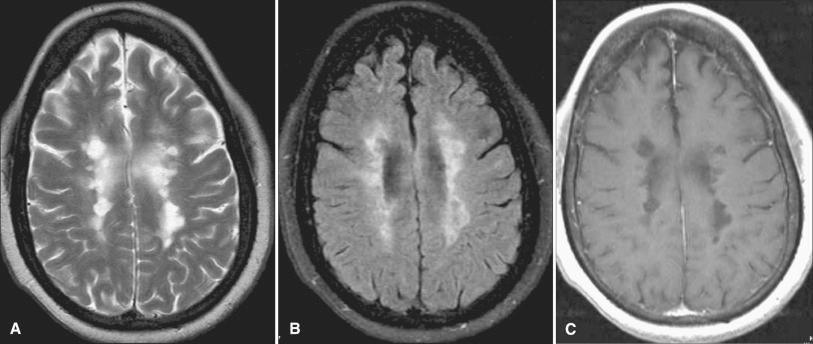
Radiographic studies have also recently provided diagnostic help in differentiating neoplasm from acute inflammatory demyelinating mass or “tumefactive MS” by the recognition of a distinctive horseshoe, or C-shaped, pattern of partial rim enhancement rather than the complete ring of enhancement seen with tumors and abscesses (see Fig. 4.22 ). Enhancement may last up to 6 months, but usually disappears within several weeks. Regional cerebral blood volume (rCBV) MR maps have shown that tumors tend to have elevated volume whereas tumefactive demyelination has diminished rCBV.
The neuropathologic hallmark of multiple sclerosis is the plaque, a pinkish-gray grossly visible focus of demyelination, which is firm (“sclerotic”) to the touch and often centered on small blood vessels, occasionally forming ovoid “Dawson's fingers.”
The microscopic patterns of demyelination in MS vary with the activity and, as recently reviewed, may have several different forms. Lucchinetti and colleagues described four patterns of active demyelination in MS. The first two patterns, in which myelin is the target of the demyelinative process, differ only in the presence or absence of bound antibody and complement and together represent the predominant forms. In patterns 3 and 4, the oligodendrocyte itself is the target of the pathogenetic process and accounts for a minority of the cases. The accurate separation and identification of these patterns at this time typically require research techniques not routinely available to most pathologists and are points of contention between investigators.
Plaques in a typical case of relapsing/remitting multiple sclerosis are often of different stages of activity, even within a single patient. Although plaques are sometimes designated early versus late or acute versus chronic, they are better identified as active and inactive since the margins of a longstanding plaque may show histologic evidence of active demyelination. However, in surgical practice, the pathologist is typically presented with an active process. Rarely are biopsies performed on well-developed chronic, inactive plaques, and patients with multiple lesions in a characteristic RRMS distribution (i.e., periventricular white matter, optic nerves, brainstem, and spinal cord) are unlikely to ever undergo biopsy. Thus, this section will focus mostly on active demyelination, often in a single poorly demarcated lesion by MRI. This pattern includes initial lesions that later evolve into RRMS or represent acute monophasic MS (Marburg disease). These classical white matter active demyelinative lesions are characterized by (1) preferential loss of myelin in comparison with axons, (2) prominent perivascular lymphocytic infiltrates, (3) a large number of parenchymal and perivascular macrophages, (4) reactive astrocytosis (which may be slight in Marburg type acute MS), and (5) cerebral edema associated with a variety of cytokines and myelinotoxic substances.
Examination of a biopsy specimen from the active edge of an MS plaque ( Fig. 24.2A ) or confluent areas of demyelination typically reveals marked cellularity, frequently with inflammatory cells infiltrating the parenchyma and clustered around blood vessels. The cellularity of the white matter may suggest a glial neoplasm, especially in frozen section preparations (see next section on tumefactive MS ), but the picture is more heterogeneous than most neoplasms. A Luxol fast blue/periodic acid–Schiff (LFB-PAS) histochemical stain for myelin helps the analysis in a number of ways. First, the edge of the developing plaque with the normal white matter is sharp enough ( Fig. 24.2B ) to decrease suspicions of glioma, although it is still somewhat ill defined compared with well-established inactive plaques. Recently engulfed myelin is represented by LFB-PAS as blue-green particles within the cytoplasm of macrophages ( Fig. 24.2C ). Lysosomal metabolism by macrophages converts the blue myelin to PAS-positive metabolites represented by red cytoplasmic droplets. Although the presence of individual foamy macrophages in a biopsied lesion can be identified in hematoxylin-eosin (H & E)–stained material, intraoperative touch preparations and CD68 immunostains ( Fig. 24.2D ) on fixed paraffin-embedded sections will more frequently bring out the intense infiltrate in the parenchyma and clustered around small venules. The presence of macrophages tends to reflect the activity of the demyelinative process more accurately than the presence of perivascular lymphocytes since lymphocytes will persist, sometimes for years, in inactive quiescent plaques.
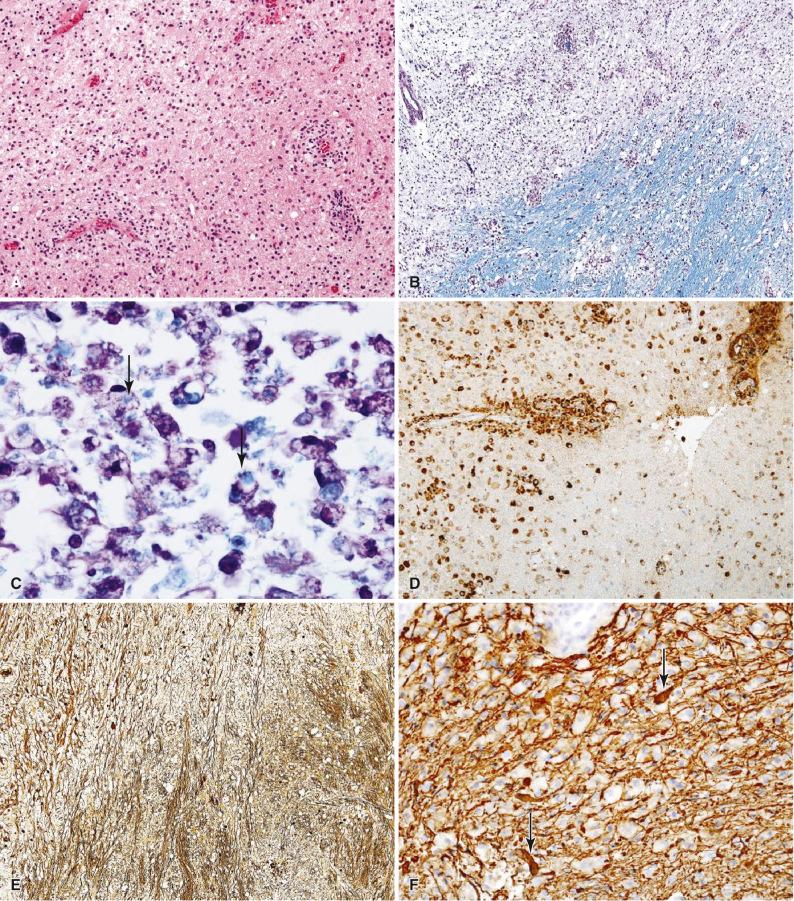
Simple loss of myelin is not the definitional characteristic of the demyelinative process, but more accurately, it is the preferential loss of myelin relative to axons. It may be difficult to appreciate axon number in the busy histologic picture of either H & E– or LFB-PAS–stained material. The use of a histochemical Bielschowsky stain ( Fig. 24.2E ) or an immunostain for neurofilament ( Fig. 24.2F ) typically shows substantially more preserved axons than expected. It is not uncommon for focally swollen axons (“axonal spheroids,” Fig. 24.2F , arrows) to be found at the edge of the active plaque. Recently, investigators have returned to the question of axonopathy in MS, initially addressed by Charcot. Active plaques and, to a lesser extent, chronic inactive plaques exhibit significant axonopathy manifest as axonal spheroids or axon loss and may underlie progressive clinical disability. Recent experimental studies suggest that axon loss may be an early and substantial alteration in MS lesions, which may even be demonstrable in areas lacking myelin loss, in which it has been loosely designated Wallerian degeneration.
Active MS plaques show a prominent lymphocytic infiltrate ( Fig. 24.2G ) within the parenchyma and in perivascular regions consisting of populations of predominantly T lymphocytes ( Fig. 24.2H ) and, to a lesser extent, B lymphocytes, the latter seen predominantly in perivascular regions in most cases. In contrast to CNS lymphoma, however, the B cells appear small and mature.
Increased numbers of reactive gemistocytic astrocytes are typical ( Fig. 24.2I and J ) and may have larger nuclei than resting astrocytes, but usually do not exhibit the marked degree of atypia of astrocytic neoplasms or progressive multifocal leukoencephalopathy (PML). Astrocyte-derived granular mitoses and Creutzfeldt cells ( Fig. 24.2K ) with numerous micronuclei may be prominent and should not be interpreted as being neoplastic.
Although rarely included in neurosurgical biopsies of demyelinative processes, cerebral cortical pathology in MS is thought to be more extensive than previously appreciated, especially in progressive forms of MS, resulting in neuron loss. In some cases cortical gray matter demyelination may be extensive, involving as much as 50% of the cortex, particularly in the frontal and temporal lobes and, to a lesser degree, in the occipital lobe. Cortical plaques may be deceptively subtle in their histology using LFB-PAS histochemistry ( Fig. 24.3A ). Only with immunohistochemistry for myelin constituents (e.g., myelin basic protein, proteolipid protein) are cortical lesions unequivocally identified ( Fig. 24.3B and C ). Inflammation within the cortex is usually much less substantial, even when white and gray matter lesions are contiguous; however, actively demyelinating processes may show microglial perineuronal infiltrates ( Fig. 24.3D ). Cortical lesions are rarely identified and biopsied in patients but may be impressive in autopsied brains.
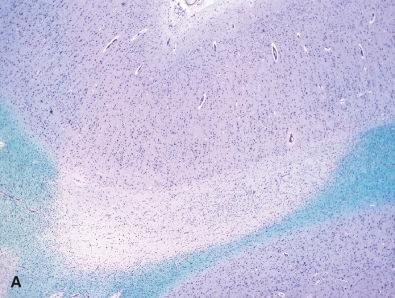
The periphery of active plaques often shows remyelination with shorter, more thinly myelinated internodes. “Shadow plaques,” larger foci with significant amounts of myelin preservation, are often located in the brainstem and are thought to represent partial remyelination ( Fig. 24.4A ). They are less pale in comparison with completely demyelinated plaques ( Fig. 24.4B ); however, the possibility of receiving such lesions in a neurosurgical biopsy specimen is remote.
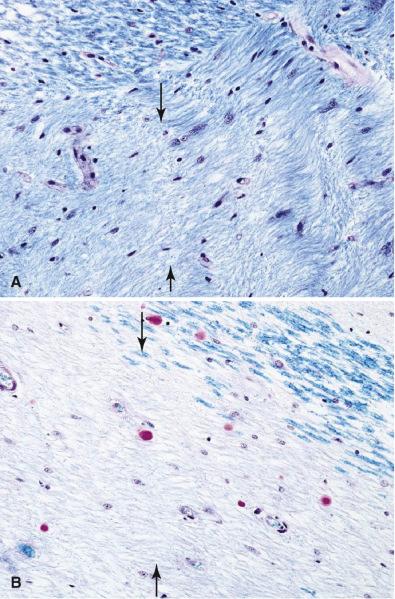
Quiescent plaques are also unlikely to be the focus of neurosurgical biopsies with the exception of being accidentally included in biopsies of adjacent active plaques. If encountered, the inactive or quiescent plaque demonstrates nearly complete myelin loss on H & E and LFB-PAS stains ( Fig. 24.5A and B ). Its margins are sharp and relatively acellular. Oligodendroglia are absent from the center of the inactive, “burned out” plaque; only naked axons, astrocytes, and their processes remain. Although there is relative axonal preservation compared to the extent of myelin loss in chronic inactive plaques ( Fig. 24.5C ), recent studies have established significant axon loss as well as ongoing degeneration of residual axons, even without remaining inflammatory cells or macrophages. It is unclear if axonal degeneration in chronic and acute lesions shares common mechanisms.
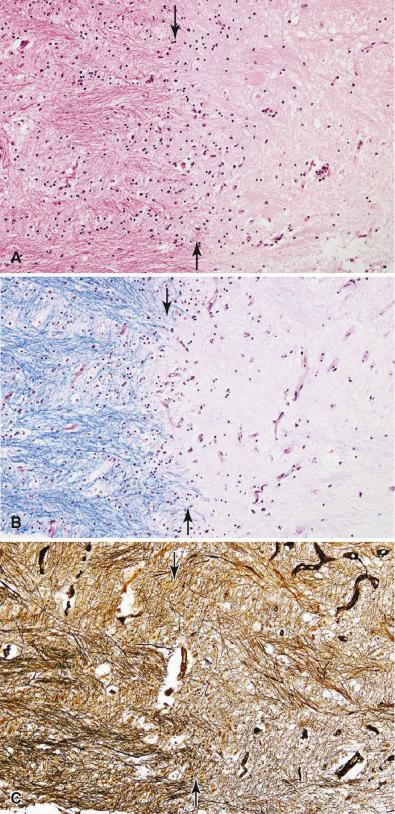
The most common subtypes of MS are described in the Localization and Clinical Manifestations section earlier in the chapter.
Areas of demyelination are large and confluent and exhibit a lesser tendency than RRMS to form discrete demyelinative foci, although they are distributed in a similar anatomic pattern. Lesions are typically of the same age and histologic appearance (i.e., it is rare for patients with acute MS to have RRMS lesions as well). Microscopically, there is loss of myelin, a decrease in oligodendrocyte number, abundant perivascular mononuclear cells, astrocytosis, increased edema, and numerous macrophages similar to an active plaque margin ( Fig. 24.6A ), but with greater parenchymal necrosis and/or axonal spheroids ( Fig. 24.6B ).
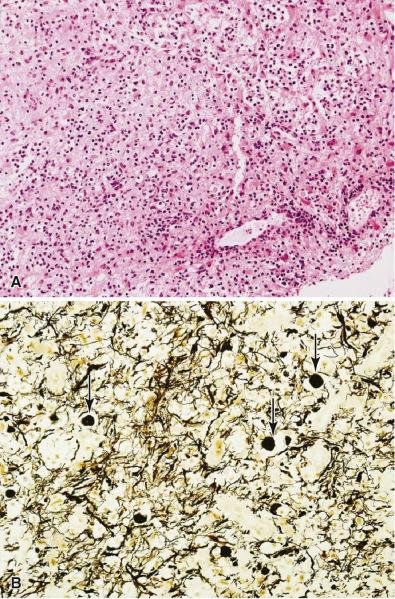
A special group of patients present with a large, unifocal contrast-enhancing cerebral hemispheric mass lesion in a clinical setting typically thought to represent a neoplastic process. Not surprisingly, therefore, this is the subtype most likely to undergo biopsy. In fact, it has been suggested that the misdiagnosis of this process as a malignant glioma represents the most common type of malpractice case in surgical neuropathology. The term “tumefactive MS” may be applied to these cases. Awareness of this pattern of inflammatory demyelination and the application of a few immunohistochemical stains should prevent misdiagnosis and lessen the likelihood that the patient will receive unneeded radiation therapy. To make matters worse, studies suggest that radiation exacerbates the neurologic deficits in these patients.
Biopsies demonstrate an acute inflammatory demyelinative process with myelin loss and relative axonal sparing that has been variously interpreted as an early MS lesion or as an intermediate entity between MS and acute disseminated encephalomyelitis (ADEM). The admixture of reactive astrocytes and the cellularity of the process may result in the mistaken diagnosis of glioma, typically a high-grade astrocytoma or oligodendroglioma. Misdiagnosis often begins at the time of frozen section in which freezing the specimen may obscure the foamy cytoplasm of macrophages, making them appear to be astrocytic nuclei in an otherwise fibrillary background ( Fig. 24.7A ). Fortunately, this pitfall may be avoided by examination of touch preparations where the cytology is much better preserved ( Fig. 24.7B ). If not appreciated, however, the mindset of the frozen section is often carried over in an attempt to classify the “neoplasm” on permanent sections. Not uncommonly, mitotic figures are seen and the examination of proliferative markers such as Ki-67 demonstrates increased proliferative activity, further contributing to the misinterpretation of high-grade glioma. However, the relatively sharp border of many of these lesions ( Fig. 24.7C ) is unusual for astrocytic and oligodendroglial tumors. A high index of suspicion and the application of special stains for myelin, axons, and macrophages usually result in the correct diagnosis. The majority of patients with tumefactive MS appear to progress to more classic forms of multiple sclerosis, although not all patients fall neatly into a well-defined diagnostic category.
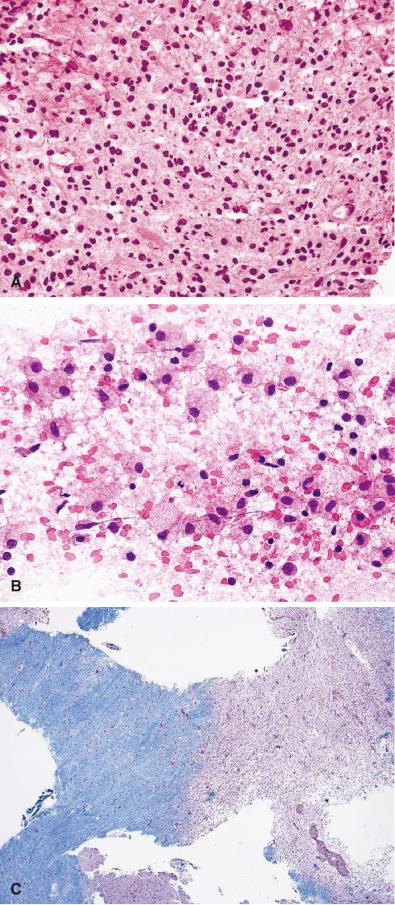
Some patients initially thought to have an inflammatory demyelinative picture have been subsequently diagnosed as having CNS lymphoma, especially those receiving corticosteroids prior to biopsy. This is thought to occur because steroids may lyse the lymphoma cells, producing a pattern difficult to separate from an inflammatory demyelinative process. One such case, initially thought to be a demyelinative process, exhibited pallor and astrocytosis ( Fig. 24.8A ), accompanied by myelin loss ( Fig. 24.8B ), relative axonal preservation ( Fig. 24.8C ), and numerous macrophages ( Fig. 24.8D ). The cellular complement also included frequent CD3 immunoreactive T cells in the absence of atypical CD20-immunoreactive B cells or Ki-67 immunoreactive proliferative elements. Nonetheless, additional fragments of adjacent brain clearly showed a diffuse large B cell lymphoma with ongoing necrosis ( Fig. 24.8E and F ). This pitfall can be avoided by using strict criteria for diagnosis of inflammatory demyelination, not accepting simple white matter pallor, preservation of scattered LFB-PAS–labeled elements within the lesion, or only rare macrophages. Small biopsies may nonetheless be problematic, and a high index of suspicion for a “sentinel lesion” of CNS lymphoma or steroid-treated lymphoma is required, particularly in older patients where tumefactive MS is less common or where the lesion seemingly “vanished” after corticosteroid therapy.
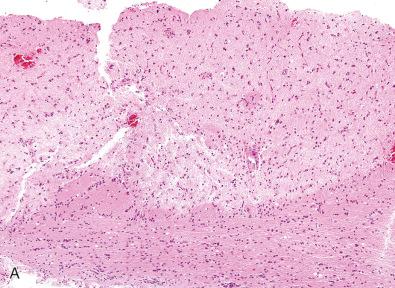
This is an extremely rare (in the United States and Western Europe) monophasic form of MS characterized by concentric rings of preserved and absent myelin ( Fig. 24.9A and B ). Demyelinated areas show macrophages with engulfed myelin debris ( Fig. 24.9C ) and, occasionally, a single axon ( Fig. 24.9D ) crossing the border between regions of demyelinated and preserved myelin. This pattern is thought to reflect oxidative damage to demyelinated zones alternating with layers of preserved myelin protected by increased expression of hypoxia-induced tissue preconditioning proteins. Concentric topographic-appearing lesions are rare but do occur in active otherwise typical lesions of acute and relapsing MS.
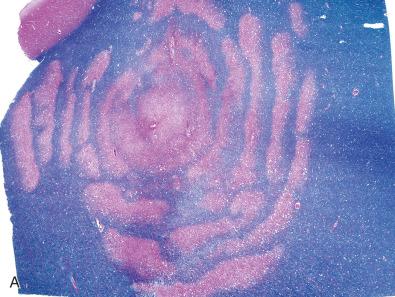
The loss of myelin is a common abnormality in white matter biopsy specimens and accompanies a variety of common processes including chronic edema. A number of diagnostic pitfalls can be avoided by only applying the diagnosis of inflammatory demyelination when all features described earlier are present. The most significant differential diagnosis is with neoplasia, as discussed previously.
However, myelin loss with macrophage infiltration is also a common histologic appearance of cerebral infarct; therefore, this process often enters the differential diagnosis (see Chapter 26 ). A sudden clinical presentation, classic radiographic appearance (particularly on serial scans), with distribution pattern in known vascular territories, and prominent cortical involvement typically lead to an accurate clinical diagnosis without need for tissue diagnosis, but clinically and radiologically atypical cases may require biopsy. Histologically, infarct is readily distinguished from inflammatory demyelination when the biopsy specimen includes eosinophilic neuronal necrosis or karyorrhectic neuronal nuclei of gray matter ( Fig. 24.10A ). If the specimen includes only white matter, it is unusual (but possible) to see significant perivascular lymphocytic inflammation in an infarct. Often infarcts contain capillary proliferations with prominent hypertrophic endothelial cells, a feature that is atypical in demyelination. The presence of a prominent reactive astrocytosis intermixed with the macrophage infiltrate favors a demyelinating disease over infarction. Although myelin loss is often complete in both infarct ( Fig. 24.10B ) and demyelination, axonal stains (Bielschowsky silver or neurofilament immunohistochemistry) in infarcts often show degraded granular axons with spheroids at the edge ( Fig. 24.10C ), rather than the long stretches of intact axons, which characterize even the most active demyelinative process. However, in some limited biopsies it may be difficult to definitively rule out an ischemic process.
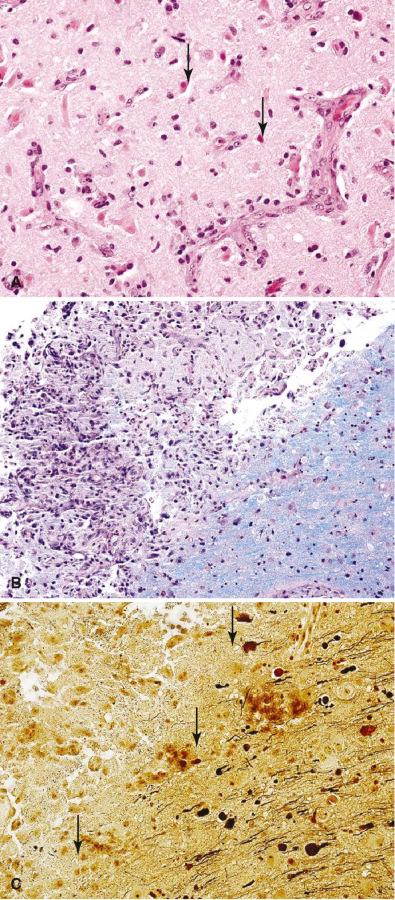
Later sections in this chapter characterize white matter damage in the setting of toxic leukoencephalopathy due to a variety of therapeutic agents, radiation damage, nutritional insult (B12 deficiency, especially in the spinal cord), hereditary disorders, and infections (PML, HTLV-1–associated myelopathy (HAM) and acquired immunodeficiency syndrome [AIDS] vacuolar myelopathy, and leukoencephalopathy). These are usually ruled out by history and, if necessary, by histopathologic examination. Other macrophage-rich processes to consider include histiocytic disorders, such as Langerhans cell histiocytosis, juvenile xanthogranuloma, Erdheim-Chester disease, Rosai-Dorfman disease, and hemophagocytic syndrome (see Chapter 17 ). Granulomatous disorders and histiocyte-rich infections such as Whipple disease are also rare considerations (see Chapter 23 ).
Additional tests that may further secure the diagnosis include craniospinal imaging to demonstrate the presence of additional lesions in typical locations, delayed visual evoked responses, and electrophoretic demonstration of oligoclonal bands and elevated IgG index in the cerebrospinal fluid (CSF) (IgG/serum IgG divided by CSF albumin/serum albumin). In most cases, a neurofilament or Bielschowsky stain to demonstrate relative axonal preservation, myelin loss identified by LFB-PAS, and the presence of numerous CD68 -immunoreactive macrophages support the diagnosis of active demyelinating disease, with additional clinical workup needed to distinguish MS from less common etiologies.
The incidence of MS is increased more than 10-fold in first-degree relatives of MS patients and in monozygotic versus dizygotic twins, but inheritance does not follow a simple Mendelian single-gene pattern. Rather, it appears that several susceptibility genes increase the risk of MS. MS has been demonstrated at increased frequency in patients with class II major histocompatibility complex (MHC) alleles DR15 and DQ6; however, the precise MHC allele is dependent on the ethnic population being examined.
A number of treatment regimens are used in the management of MS. Steroids shorten attacks of MS, but chronic steroid treatment has not been found to be of benefit over the long term, although possible pulsed steroid use may be helpful. Reduction of relapses by type I beta-interferons (Avonex, Betaseron, Rebif, Extavia, Plegridy), glatiramer acetate, and natalizumab (a monoclonal antibody directed against the alpha subunit of VLA-4, preventing tissue access of inflammatory cells) has been shown in treatment of RRMS over more than a decade. Drugs for the treatment of SPMS are more limited and may be more toxic. No effective treatment of PPMS has been approved, although a monoclonal antibody to CD20 on B lymphocytes is under review at FDA. Treatment of acute Marburg type MS with steroids and plasma exchange may be helpful.
Neuromyelitis optica (also called Devic disease ) is a disease of children and adults, previously thought to represent a variant of acute MS in which there is the near simultaneous development of optic neuritis and transverse myelitis. Neuropathologic findings combine a marked, frequently necrotizing myelinopathy involving optic nerves with longitudinally extensive (more than three vertebral segments) myelitis. Lesions that are not confined to spinal cord and optic nerves and involve basal ganglia, hypothalamus, area postrema (correlates with symptoms of nausea/vomiting), and cerebellum (among other areas) are designated “NMO spectrum disorders (NMO-SD).”
The initial description of a series of patients with rapid visual loss and cord signs was made by Drs. Devic and Gault in the late 19th century. Because of its demyelinative appearance, predilection for optic nerves and spinal cord, and occasional areas of hemispheric myelin damage, NMO has long been considered a form of MS. NMO can be monophasic or relapsing, and optic nerve and spinal cord disease do not necessarily occur concurrently. When relapsing, NMO patients have a higher attack frequency, an increased age at onset, are not typically familial, show more prominent necrosis of optic nerves and spinal cord, have a neutrophilic and occasionally eosinophilic CSF pleocytosis with rare and nonpersistent oligoclonal bands, and have a poorer prognosis in comparison with typical MS.
Recent studies, however, have demonstrated that the immune attack in NMO is not directed against a myelin or oligodendroglial component but against the astrocytic water channel aquaporin 4 (AQP4), which is present in high concentration in the spinal cord, diencephalon, and periventricular zone—that is, sites preferentially targeted in NMO. IgG anti-AQP4 binds to the astrocytic processes lining the glia limitans and Virchow-Robin spaces adjacent to microvessels. Demyelination may represent a bystander effect on oligodendroglia, myelin, and/or interference with myelin regeneration. Therefore, NMO is now thought to represent an autoimmune disease separate from MS.
As in other autoimmune diseases, adult women comprise a significant majority of NMO patients (female to male ratio is 9 to 1), well in excess of that found in MS. There is a predilection of NMO for Asians (in which the disease likely includes patients with NMO-IgG–positive opticospinal multiple sclerosis, OSMS). Asians only infrequently have typical RRMS.
The precise incidence of NMO is not securely known at this time, since it has often been misdiagnosed in life as MS or ADEM, the correct diagnosis being established at autopsy. With the recognition that the majority (75% to 80%) of patients with NMO or NMO-SD can be identified by circulating NMO-IgG directed against AQP4, the number of patients correctly diagnosed during life is now increasing.
The characteristic involvement of optic nerves and spinal cord produces a rapidly evolving or relapsing-recurring picture with a predictable constellation of clinical symptoms, including decreased visual acuity and loss of visual fields accompanied by sensory loss, weakness, and problems with control of bladder or bowel function.
NMO lesions in spinal cord show increased T2-weighted signal involving more than three vertebral segments. Acute lesions may have extensive gadolinium enhancement. NMO typically lacks the brainstem and hemispheric white matter changes of MS, although we have encountered a recent case that showed cavitating lesions involving the centrum semiovale ( Fig. 24.11A ). At autopsy, patients may show gross pathology involving optic nerves and spinal cord, ranging from gelatinous discoloration to yellowish granular foci of necrosis to cavitation.
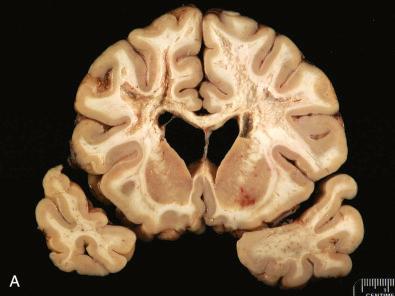
It is not uncommon to receive limited biopsies of spinal cord processes; thus, the possibility of NMO must be considered for extensive spinal cord lesions that occur as isolated or recurrent forms of transverse myelitis. White matter damage in NMO is typically more destructive than spinal cord and optic nerve involvement in chronic relapsing MS and may masquerade as ischemic disease. Indeed, secondary swelling and ischemia may contribute to the pathology by interfering with blood flow. Some areas in NMO show fairly typical demyelinative pathology, one of the reasons NMO was originally designated a form of MS. Differences between NMO and MS include active destructive lesions ( Fig. 24.11B ) with not only T cells and macrophages, but also granulocytes and eosinophils ( Fig. 24.11C ), frequently accompanied by hyalinized vasculature. NMO fails to produce cortical lesions, in contrast to MS, a finding that remains a mystery since AQP4 is also present on cortical astrocytes. LFB-PAS and neurofilament (or Bielschowsky) stains demonstrate myelin loss with significant axonal interruption and loss in excess of that in typical MS lesions.
The distribution of AQP4 in normal spinal cord consists of perivascular small punctate foci ( Fig. 24.12A ). Immunohistochemical studies of active NMO lesions show parallel loss of AQP4 and glial fibrillary acidic protein (GFAP) ( Fig. 24.12B and C ) as might be expected in an astrocytopathy, which contrasts with ADEM and MS lesions in which AQP4 and GFAP are maintained/increased ( Fig. 24.12D and E ). NMO lesions show vasocentric immunoglobulin and complement deposition (e.g., particularly C9) neoantigen resulting in vacuolar myelinolysis and eventual loss of both astrocytes and oligodendrocytes. AQP4 immunohistochemistry demonstrates marked disruption and swelling of astrocyte cell bodies at the margins of lesions ( Fig. 24.12F ) and in the perivascular distribution of end-feet ( Fig. 24.12G and H ). GFAP immunohistochemistry in some NMO cases demonstrates clasmatodendrosis or swelling of pruned astrocyte processes ( Fig. 24.12I ). Complement-mediated astrocyte damage is thought to occur first, followed by granulocyte infiltration, and oligodendrocyte death.
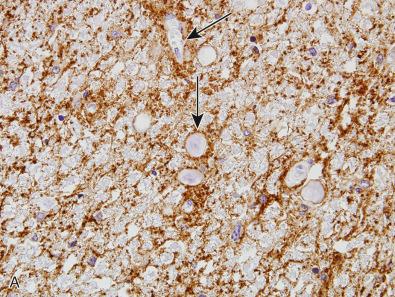
Reparative gliosis in NMO involves small AQP4-negative astrocytes that do not reform astrocyte end-feet or result in the reappearance of oligodendrocytes. Early MS lesions showed a loss of astrocyte end-feet and some loss of astrocyte perikarya followed by the appearance of large AQP4-positive astrocytes that often reform vascular end-feet.
Based on recently developed serologic testing methods, the spectrum of NMO is expanding to involve patients with single attacks or recurrent forms limited to either optic nerve or spinal cord, as well as those with lesions involving other brain regions (hypothalamus, brainstem) that may be considered part of an NMO spectrum disorder. However, investigators have recently claimed that there is increased complexity of NMO lesion pathology, proposing six different lesion types, which suggests that specific biomarkers for NMO spectrum disorders are not simply nonspecific markers of destructive immune mediated diseases.
The differential diagnosis includes RRMS, ADEM, paraneoplastic or infectious causes of transverse myelitis, neurosarcoidosis, myelopathy in systemic lupus erythematosus (SLE), infarction of the spinal cord, and spinal cord neoplasia. Although the histopathology of NMO is significantly different from each of these entities, there may be some overlap with inflammatory conditions, particularly with the limited size of biopsy specimens. Therefore, serologic tests are critical in establishing a diagnosis. NMO is often associated with other autoimmune diseases, such as SLE or Sjögren syndrome, and NMO patients often demonstrate multiple serum autoantibodies, including antinuclear antibody and extractable nuclear antigen; this may confuse the diagnosis.
A diagnostic serologic test is available in some laboratories and demonstrates the presence of NMO-IgG antibody against aquaporin-4. The antibody is highly specific for NMO, but is not sensitive, being positive in only about 75% of NMO and NMO-SD patients. NMO-IgG is not demonstrated in any patient with typical MS, longitudinally extensive transverse myelitis, monophasic optic neuritis, or acute disseminated encephalomyelitis. GFAP levels measured in CSF of patients in the acute phase of NMO are markedly elevated compared to MS, likely reflecting massive astrocytolysis in NMO.
NMO has a predilection for Asian populations, suggesting a possible genetic association. Studies have shown that Western-type MS in Japanese patients is associated with HLA allele DRB1*1501, as in Western populations, and NMO (or OSMS) is associated with HLA DPB1*0501 6. In 30% to 60% of OSMS patients, NMO-IgG is positive, and, in these patients, OSMS is thought to be the same entity as NMO.
Steroids and other immunosuppressive agents have been used to some effect in patients with NMO. In support of an antibody-mediated pathogenesis, patients with NMO who do not respond to steroids may respond dramatically to plasma exchange. In the past, mortality reached 50% but is now approximately 10%. Although substantial recovery typically occurs in NMO patients, it is incomplete.
Acute disseminated encephalomyelitis represents a typically monophasic inflammatory autoimmune demyelinative attack on CNS white matter and myelin, which typically follows within a short time of an inciting event. It results in innumerable punctate foci of demyelination that are typically centered on small veins and venules. ADEM has been variously called perivenous, postinfectious, or postvaccinial encephalomyelitis.
The first reported cases were in the 1920s, and involved children and young adults, apparently as an increase in incidence in response to smallpox vaccination.
Although patients of any age, gender, and ethnicity can be affected, ADEM has a predilection for children (constituting most cases) and young adults. A precise incidence is unclear since the number of subclinical cases may outnumber those with clinical presentation. The incidence following measles, the most common viral association, is estimated at 1 case per 1000.
This is an acute, typically monophasic, demyelinative disease of children and adults that typically involves the white matter of the cerebral centrum semiovale, cerebellum, brainstem, and spinal cord. The syndrome often has a predisposing event a few days to several weeks previously, which has included (1) measles, mumps, varicella, influenza, rubella, or other viral infections (often with waning of the primary infection); (2) smallpox vaccination; (3) immunization against rabies (particularly with an inoculum inadvertently contaminated with CNS tissue in early immunization procedures); (4) bacterial infections such as Mycoplasma pneumoniae or Campylobacter jejuni; and (5) no identified predisposing cause. Patients may develop headache, fever, and vomiting followed by weakness, ataxia, visual and sensory loss, and, if severe, stupor and seizures. The course is short and may occasionally be fatal, but most patients recover.
Typically, ADEM is diagnosed without biopsy since the radiographic picture and clinical presentation is characteristic. MRI typically shows numerous small T2-weighted hyperintense and FLAIR MRI sequence lesions in the subcortical and periventricular white matter, often accompanied by a few larger aggregated confluent lesions and, to a lesser degree, spinal involvement. The process typically involves white matter and may occur at any level of the CNS including deep gray matter and cerebral cortex. The gross appearance of the brain may be normal or show edema and tiny foci of white matter discoloration with central small vessels and, rarely, petechial hemorrhage.
Lesions typically consist of perivenous foci of demyelination, which may be subtle on H & E stains ( Fig. 24.13A ) but are striking with myelin stains ( Fig. 24.13B ). Demyelination with relative axonal preservation is accompanied by macrophages and a microglial and mononuclear cell infiltrate. Cases in which large tissue samples are evaluated are more likely to provide a diagnostic specimen since it is important to see a pattern of selective perivascular demyelinative foci ( Fig. 24.13B ) with relative axon sparing ( Fig. 24.13C ) rather than the confluent lesions of MS, which also may have plaques with perivascular extensions. Limited biopsies in which a few foci of involvement are present are more likely to receive a diagnosis of “inflammatory demyelination” since a unifocal demyelinative lesion of MS may be difficult to separate from ADEM. Indeed, hybrid or transitional cases of apparent MS/ADEM have been reported. Recovery may be followed by apparent remyelination with improvement of the radiographic appearance. Postmortem examination of cases surviving for extended periods after an episode of ADEM shows remyelination or only subtle evidence of prior damage (e.g., perivascular fibrosis and gliosis).
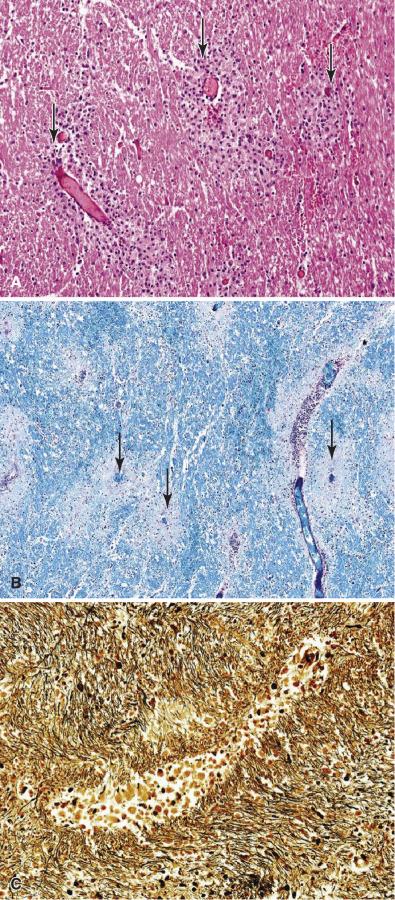
Possibly, sensitization to some altered CNS antigen during immunization or a viral infection with cross reactivity (“molecular mimicry”) between a viral antigen and CNS white matter may provide the trigger for the process. ADEM resembles the human equivalent of the acute monophasic form of experimental allergic encephalomyelitis (EAE), produced in rodent models by immunization with myelin or white matter constituents and that may be passaged with sensitized T cells from symptomatic animals.
Quite rarely, patients exhibit a relapsing-recurrent or progressive form of ADEM in which the final appearance at autopsy retains a perivenous distribution and does not closely resemble MS; however, some hybrid cases of MS and ADEM have been proposed.
The differential diagnosis includes MS (usually ADEM patients are younger), vasculitis (which tends to involve both gray and white matter with angionecrosis), SLE, PML, thromboembolism (particularly of fat particles), meningoencephalitis, and acute hemorrhagic leukoencephalitis (see next section), with only the latter typically proving difficult on microscopic analysis.
Histochemical studies of LFB-PAS (myelin) and Bielschowsky or neurofilament immunohistochemistry (axons) demonstrate the demyelinative nature of the process. Immunostains for CD68 and CD3 typically illustrate the perivascular macrophage and T cell–dominant cellular prominence in ADEM.
Association of ADEM with certain HLA subtypes has been reported.
Patients may respond to intravenous (IV) corticosteroids, plasmapheresis, or IV immunoglobulin therapy. Mortality is usually low with patients recovering, although those affected seriously enough to require admission to the intensive care unit showed 25% mortality in one study. Patients may be left with significant residua.
Acute hemorrhagic leukoencephalitis (AHL, also known as Weston Hurst disease or Hurst disease ) represents an acute demyelinative/destructive process in which perivascular demyelination, vascular necrosis, and superimposed white matter ischemic lesions are typical.
This disease was first characterized by Hurst in his 1941 study of a group of patients with abrupt onset of fever, seizures, a rapidly progressive neurologic demise, and fatal outcome.
Patients of all ages are susceptible to the disease, most of which have had an episode of upper respiratory tract infection, usually within 2 weeks of onset of the CNS disease. There is little evidence for an ethnic, geographic, or gender bias.
Typically, AHL involves subcortical and deep cerebral white matter, but cases in which the spinal cord is preferentially involved have been encountered. AHL is a monophasic, rapidly progressing, frequently fatal disease. It may accompany exposure to an upper respiratory infection, a variety of drugs (including penicillin and sulfonamides), or several viral exanthemas, or follow immunization. Clinical manifestations include abrupt onset of fever, stiff neck, seizures, impaired consciousness, hemiplegia, and other superimposed focal signs.
Become a Clinical Tree membership for Full access and enjoy Unlimited articles
If you are a member. Log in here